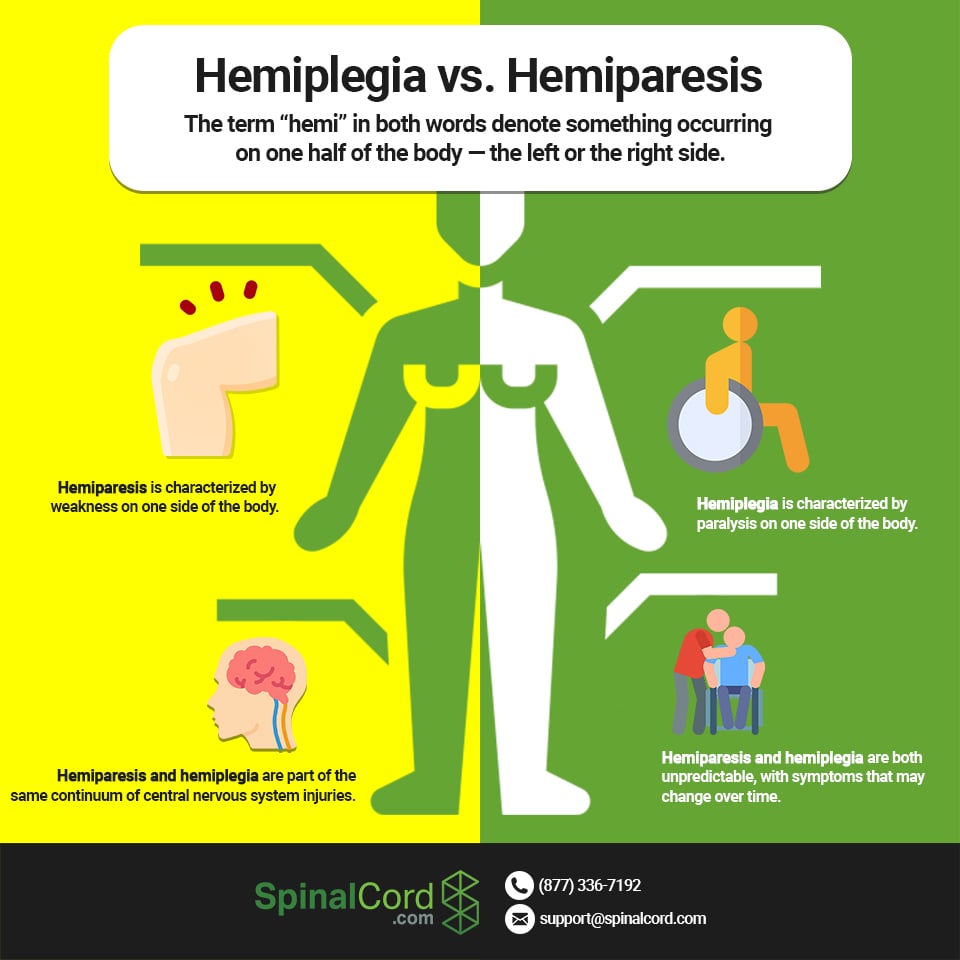Hemiplegia vs Hemiparesis: Causes, Symptoms, and Treatment
There are multiple forms of disability that a person can suffer as a result of a spinal cord injury (SCI) or traumatic brain injury (TBI). Two conditions that many people get confused are hemiplegia and hemiparesis—likely because of their similar names.
To help you learn more about these conditions, here’s a quick explanation of hemiplegia and hemiparesis, as well as what makes them different.
Hemiparesis Definition
The term “hemi” in hemiplegia denotes something occurring on one half of the body — the left or the right side. Hemiparesis is weakness on half of the body. This may manifest in multiple ways, such as a loss of motor control, inability to feel one side of the body, or general sensations of weakness.
Right Hemiparesis vs Left Hemiparesis
As the name implies, right hemiparesis is weakness on the right side of the body, while left hemiparesis is weakness on the left side of the body. What causes this weakness in one side of the body and not the other varies, but damage to the nervous system from injury, infection, or degenerative conditions can result in hemiparesis.
In the case of degenerative conditions such as multiple sclerosis or amyotrophic lateral sclerosis (ALS), hemiparesis may progress into hemiplegia with time.
Symptoms of Hemiparesis

It’s common for hemiparesis to unevenly affect one side of the body. The disorder is on a continuum, with symptoms ranging from minor and sporadic to extensive and severe. Telltale signs include:
- Difficulties with motor skills, particularly standing.
- Weakness in large areas on one side of the body. For example, a patient might be unable to lift his or her arms.
- Pusher syndrome: a common byproduct of traumatic brain injuries, pusher syndrome causes a person with hemiparesis to shift their weight to the affected side, thereby undermining motor skills and making walking difficult and potentially painful. Doctors use a scale to assess the severity of pusher syndrome. This scale can help doctors make accurate prognostications, in addition to identifying the cause of symptoms.
- Strain on the unaffected side of the body, which may overcompensate for injuries on the hemiparetic side.
- Unusual sensations or tingling on the affected side.
Importantly, doctors will look for injuries on the affected side to rule out other causes, such as pinched nerves, muscle strains, or loss of blood flow.
Hemiplegia Definition
Where hemiparesis indicates weakness on one side of the body, hemiplegia indicates partial or total paralysis instead. Because paralysis is an extreme form of weakness and nerve dysfunction, hemiplegia can be considered an extreme form of hemiparesis.
Hemiplegia should not be confused with paraplegia, which is a condition that affects the lower body. However, the causes of hemiplegia and paraplegia are frequently similar.
Right Hemiplegia vs Left Hemiplegia
Left hemiplegia is the paralysis of limbs on the left side of the body, while right hemiplegia indicates paralysis on the right side of the body. Like hemiparesis, right or left hemiplegia may be caused by damage to the nervous system.
One common cause of left or right hemiplegia is an incomplete spinal cord injury. In an incomplete SCI, only part of the spinal cord is severed, so there may still be some function below the injury site. For example, an incomplete spinal cord injury in the cervical spinal cord might paralyze the left side of the body while leaving the right side functional — though this isn’t guaranteed because the specific nerves severed may alter the effects of the injury.
Symptoms of Hemiplegia
Paralysis can change over time, and not all people with hemiplegia are completely immobilized or suffer a complete loss of sensation on the affected side. Nevertheless, if paralysis is not extensive, a doctor will likely diagnose hemiparesis instead of hemiplegia. Symptoms of hemiplegia include:
- Difficulty moving, or the inability to move, one side of the body.
- Difficulty with bowel or bladder control.
- Changes or loss in sensation on one side of the body.
- Keeping one hand in a fist.
- Difficulty swallowing or with speech.
- Breathing difficulties.
Hemiplegia can change over time, such that some areas of the affected side may be more significantly affected than others.
Hemiparesis and Hemiplegia Causes
There are a number of conditions that can cause hemiparesis or hemiplegia. Examples of hemiparesis and hemiplegia causes include strokes, brain injuries, spinal cord injuries, infections, and a handful of other conditions affecting the central nervous system.
Both hemiparesis and hemiplegia are nervous system disorders, not caused by injury to the affected side of the body. For example, an injury to the spinal cord or brain interferes with the body’s ability to send or receive signals to the region of the body affected by the injury. So, while the left or right side of the body haven’t been damaged directly, the spinal cord injury may cause hemiparesis or hemiplegia.
The most common cause of both injuries is a stroke. Strokes interfere with blood flow to the brain. If a region of the brain that affects movement or perception is affected, hemiparesis or hemiplegia may develop. The affected region is usually the opposite of the side of the brain affected, so an injury to the right side of the brain will affect the left side of the body.
Some other causes of hemiparesis and hemiplegia include:
- Brain infections such as meningitis or encephalitis
- Brain cancer or lesions
- Damage to the neurons due to a degenerative disorder such as Parkinson’s
- Traumatic injuries, such as a blow to the head during a car accident
- Congenital disorders such as cerebral palsy
Rarely, psychological conditions can manifest as hemiparesis or hemiplegia. When this occurs, doctors must treat the psychological issue, not the physical symptoms.
Hemiparesis vs Hemiplegia
Hemiparesis and hemiplegia are part of the same continuum of central nervous system injuries. Both interfere with movement and sensation. Both can be difficult to treat, and often severely constrain normal functioning.
Though the symptoms are different, the two conditions are essentially different versions of the same underlying problem. Mild to moderate nerve or brain damage will produce hemiparesis, while moderate to severe nerve or brain damage will result in hemiplegia. Moreover, the same injury can produce both symptoms at different times. This is especially true when nerves are compressed or the spinal cord is swollen, since changes in swelling or compression can also produce changes in symptoms.
Particularly early in an injury’s course, it’s impossible to determine whether a patient will be left with hemiparesis or hemiplegia.
What’s the Difference Between Hemiparesis and Hemiplegia?

Hemiparesis is characterized by weakness on one side of the body. A person with hemiparesis might not be able to move their arm, or may feel tingling or other odd sensations on just one side.
Hemiplegia is paralysis on one side of the body. Though stereotypes of paralysis suggest that paralysis completely removes the ability to move, the reality is a bit more complicated. People with paralysis may retain some sensation, and the degree to which they are paralyzed can change over time. Thus it can be hard to establish a clear line that separates hemiparesis and hemiplegia, particularly in the case of mild hemiplegia and severe hemiparesis.
Treatment for Hemiparesis and Hemiplegia
Though hemiparesis and hemiplegia produce different symptoms, they are substantially similar in cause and treatment. To treat either condition, a doctor will first look at what caused the symptoms. When an infection, growth, or other medical issue causes symptoms, a doctor may first address these symptoms. When a stroke is the culprit, the stroke itself cannot be reversed, but a number of treatments may help restore some or all functioning:
- Physical, occupational, or exercise therapy to restore functioning and help the brain work around the injury.
- Assistive devices such as walkers or wheelchairs.
- Occupational therapy to support independence.
- Psychotherapy to address the psychological impact of a severe injury.
- Alternative treatments such as acupuncture and dietary changes.
Prognosis for Hemiparesis and Hemiplegia
Hemiparesis and hemiplegia are both inherently unpredictable, with symptoms that may change over time. Prompt intervention, including extensive physical therapy, can substantially improve the chances of a full recovery. Psychotherapy is also important, since the overwhelming nature of these injuries can interfere with a patient’s ability and willingness to stick with treatment.
Every patient is different, but there is no way to conclusively predict the prognosis of these disorders. Some people spontaneously recover, even with no treatment. Others make little progress, even with extensive treatment. In general, however, the more aggressively a patient works to recover some functionality, the more likely a full or partial recovery becomes.
Do you have more questions about hemiparesis, hemiplegia, paraplegia, or other conditions related to SCI and TBI? Reach out to the spinalcord.com team for answers!
Sources
- What is hemiplegia? Contact. https://contact.org.uk/advice-and-support/health-medical-information/hemiplegia-support/what-is-hemiplegia/ Accessed May 11, 2020.
- What is Hemiplegia. Epilepsy Society. https://www.epilepsysociety.org.uk/what-hemiplegia#.XrmRbBNKjjB Published December 28, 2018. Accessed May 11, 2020.
- Demeurisse G, Demol O, Robaye E. Motor Evaluation in Vascular Hemiplegia. Karger Publishers. https://www.karger.com/Article/Abstract/115178 Published 1980. Accessed May 11, 2020.
Stay Updated on Advancements On Traumatic Brain &
Spinal Cord Injuries
About the Author





